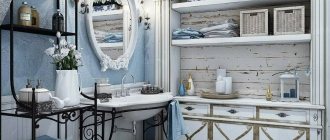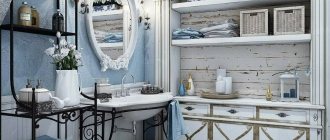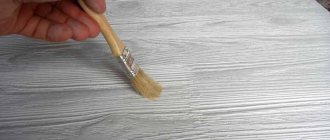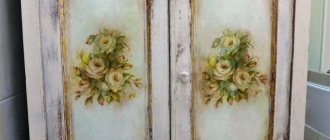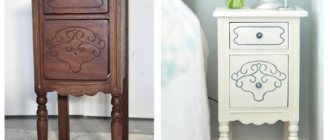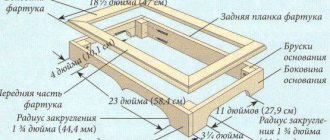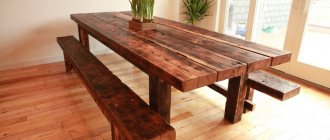Several centuries ago, an interesting technology for decorating furniture appeared in Germany. Not everyone could afford artistic painting back then; people often decorated cabinets, chests of drawers, and boxes with paper pictures, securing them with varnish. This is how the decoupage technique arose, which is still popular today. Today, anyone can decoupage furniture in the Provence style; the master class will help you do everything correctly and avoid common mistakes. The advantage of the technique is that the work does not require special skills or expensive materials.
Features of the Provence style
Provence is a more sophisticated analogue of American country. The style of the French countryside is distinguished by both simplicity and sophistication, elegance and modesty, an affinity for vintage furniture, naivety and idyllic tranquility. It is sincere and cozy, like a grandmother’s village house from childhood memories. It is especially common in kitchens, but can also decorate other rooms: living rooms, dining rooms, bedrooms.
Rare or antique furniture is very elegant and beautiful, but not everyone can afford this pleasure.
Style Features:
- Antique or artificially aged furniture.
- Natural flowers.
- Decoration with floral and rustic ornaments.
- An abundance of things from the “good old days,” from grandma’s box to antique trinkets bought at a flea market.
- Decoupage, sewing, ruffles and other handmade decor, made with your own hands.
- Softness, naturalness and variety of materials.
Slightly “faded” and dull colors, rustic but practical and high-quality things, rough plaster and natural textiles - this is interior design in the spirit of “French country”. There is no place for pomp, deliberate pretentiousness and arrogant luxury. The cold shine of metal, polished surfaces and modern furniture “monsters”-transformers are inappropriate. Everything is homely, cozy and modest, but at the same time subtly elegant.
Before you start aging furniture on your own, it is necessary to thoroughly prepare all wooden surfaces that will be processed.
Decoration
Decoupage is the DIY painting of old pieces of furniture. You don’t have to be scared, because anyone can do this, and it’s not at all necessary to have special artistic skills. Accuracy and perseverance are enough. This will also be an ideal option for people who do not have enough financial resources, since this method of transforming old furniture will be very inexpensive, or for those who want to transform an old cabinet into something new and unique. After all, a thing made with your own hands is unique. There are several options for how to decoupage a cabinet in Provence style. You just need to choose the most suitable one.
The advantages of doing it yourself
Before we figure out how to paint furniture in the Provence style, how and in what ways to decorate it, let’s decide why this is needed at all. So, what are the advantages of restoring furniture and decorating a room in the spirit of the French countryside:
- Saving. Provence is much cheaper than classic, high-tech and most other styles.
- You don't even have to buy furniture. An existing one, artificially aged and restored, will do.
- Possibility of using old interior elements.
- Moral satisfaction, pride in what you have done with your own hands.
To make your furniture look shabby and worn, you can use the painting technique.
Interior furnishings in the old French style
For decoration in Old French design, surfaces made of natural wooden materials with the addition of forged iron elements are usually used. Modern interior items made from innovative materials (chrome, nickel, aluminum, glass furniture, etc.) do not fit into this atmosphere at all, but even artificial materials like wood are perfect for painting furniture with a unique style Provençal province, painted in delicate pastel shades.
A wicker chair, a forged cornice, furniture with intricate ornaments and ornate motifs, in general, anything that contains a touch of antiquity, a grandmother’s wooden chair, a chest of drawers, a bed or a chest, fit perfectly into such an atmosphere, proving with all its appearance that it has served for more than one generation. In principle, it is possible to apply this style in all rooms of your home; the most important thing is to have the necessary items on hand and learn how to age them with your own hands.
Read a separate article on how to paint a chair.
Decorating any room using this method will combine comfort and ease of use.
Specifically, the Provence style brings associations not only with the classic French village, but also with a place to relax.
DIY furniture aging techniques
You can “age” a chest of drawers or sideboard in different ways. Let's look at the basic techniques.
Regular painting
- Preparatory stage: remove the old varnish with coarse-grain sandpaper, sand the surface with fine-grain paper.
- Painting. Pastel colors predominate in Provence. We choose the paint accordingly.
- Use iron wool (an abrasive material sold in hardware stores) to dry the surface until dark lines and spots appear.
- Paint the fittings with the same paint, dry, then clean with a wire brush.
New elements of fittings also need to be aged - after all, they can give away your trick with furniture.
Paint and paraffin
The aging effect can be achieved with ordinary paraffin. To do this, the coating is removed in some places with sandpaper. Then the working areas are rubbed with paraffin, and paint is sprayed on top using an aerosol can. It’s not scary if the coating is uneven - such negligence is quite consistent with the spirit of Provence.
The combination of a rich base and a light second layer will create the effect of faded paint.
Cleaning and bleaching
Whitening can be done either with a special whitening paste or by grinding. The paste is only suitable for porous wood. For example, oak or ash.
To consolidate the effect for a long time, coat the finished furniture with clear varnish.
Whitening:
- Thorough surface cleaning. Removing the varnish and sanding first with coarse sandpaper, then with finer-grain paper.
- The “aging” areas are covered with blue or brown paint, dried, and rubbed with paraffin.
- Paint the furniture by applying several layers of white paint.
If the base paint or wood is dark in color, use nitrocellulose varnish. For light breeds, a water-based varnish is suitable.
Patination at home
Patination can be carried out in dozens of ways and materials. At home, the easiest way is to purchase a patination composition. You can find it in any construction supermarket. First, the surface is prepared, painted, and varnished. We sand the dried furniture with 240-280 grit sandpaper. Then a patination preparation is sprayed onto the surface from a can. After this, the patina is removed with iron wool, remaining only in the recesses.
Patina appears on the surface as a result of many years of oxidation of paint, varnish or metal and is especially valued by connoisseurs.
Using craquelure varnish
Craquelure varnish is a varnish used to make craquelures. Unclear? It’s simple: craquelures are decorative cracks that create the effect of furniture cracked by time. The method is quite complicated and requires certain skills. Not for beginners.
Create an imitation spider web from cracks in an old protective coating on a dresser.
Several ways to age furniture surfaces
Artificially aged furniture looks as excellent as truly antique furniture. However, it is much easier, faster and cheaper to do.
Of the ways in which you can age furniture yourself at home, there are three main ones:
- Mechanical . Thanks to this method, artificial scratches, cracks and other damage appear on furniture.
- Chemical . In this embodiment, substances such as craquelure varnishes, ammonia, stain and much more are used.
- Thermal . Using an open fire or a soldering iron, an antique effect is achieved.
What tools and materials will be needed
We will combine several techniques in one master class. To decorate furniture in the Provence style with your own hands, we will need the following tools and materials:
- Brushes, wide and narrower for “spot” painting.
- Acrylic water-based paint.
- Patination composition (in our case – bitumen varnish).
- Paraffin.
- Putty.
- Hairdryer (to speed up drying).
The set will depend on what kind of item is being aged and what method is used.
Material
In order to create a cabinet in the Provence style, you need to take only natural and best materials, real wood. If desired, they can be decorated with carvings or artistic painting. The cabinet itself is simple and classic in shape, and an important nuance is laconicism. And you don’t have to worry that this will make the room look too pretentious. And all thanks to the coating, which should be simplified to the maximum or specially aged.
By the way, inexpensive cabinets in the Provence style are produced by many excellent companies - beautiful designs, interesting and sophisticated colors, hand-cut or painted. And they are made from the best natural materials. But you can make a Provence style cabinet yourself, and then it will be much cheaper. You can create whatever you want, depending on your flight of fancy and desires.
Step-by-step master class on aging furniture
- Applying a base coat of paint.
- Drying. You can use a hair dryer to speed up the process.
- Treatment of aging areas with paraffin.
- Adding putty for relief and creating the effect of a multi-layer coating.
- Creating a worn effect. This is achieved by friction with sandpaper, a stiff brush or iron wool... or by applying paint with a sponge, then the previous layer will be perceived as abrasion.
- Painting in several layers.
- Sanding.
- Patination.
- Drying.
After complete drying, you can begin sanding the area to be treated, then begin decorating.
If you have decorating skills, you can additionally paint furniture in the Provence style with your own hands. Floral ornaments and images with rural motifs will look especially organic.
You can use decoupage napkins with designs in the Provence style, which are transferred to furniture.
Stencil painting of a cabinet
The main advantage of stencil painting is that with high-quality preparation of furniture, painting itself will not take much time. Also, this type of design is very simple to implement, even a beginner can handle it. Simply cut out a stencil of floral motifs and attach it to the surface, then apply paint. It is most convenient to use stencils on a self-adhesive basis; they are easy to stick, the paint does not flow beyond the borders, and they are also easy to remove when the design has dried.
Before you start applying paint, it is best to wipe and degrease the surface again.
It is better not to remove the stencil from paint that has not yet dried. But don’t wait until it’s completely dry, find a middle ground and remove the stencil. After which you can work on the edges of the painting again and remove flaws and blemishes.
If you reuse the same stencil, be sure to thoroughly clean it of any traces of paint before using it a second time.
It is not necessary to draw in one color. You can combine several shades, especially since pastel colors complement each other well.
This way you can decorate all the furniture in the room, not just the closet.
Ready-made examples of aging different furniture with your own hands
The chest of drawers “aged” using the reverse patination method looks good. In this case, abrasions are achieved not by rubbing off the patina, but by rubbing away the underlying layer of paint.
An old Soviet cabinet restored in Provence style with an attached additional storage system in the form of a bookcase.
If the work is done correctly and in compliance with the appropriate instructions, furniture made in this style will give the room a feeling of comfort and coziness.
Rack and shelf, aged with patina.
Provence creates a lovely homely coziness and a comfortable indoor environment.
In addition to aging furniture, the Provence style can always be complemented by decoration using decoupage techniques and other types of painting. Antique trinkets, handmade souvenirs, and fresh flowers will look great in this interior.
Any antique item can be restored, repainted and given a decorative role in the Provence style.
Aging to renew: restoration of Provence furniture
Buying artificially aged furniture is not difficult: the supply generated by demand has suggested a profitable niche to manufacturers. There is another option, thanks to the advice of experts from the WESTWING shopping club, existing furniture is transformed: Provence is accessible even to a novice designer.
Wooden furniture primarily requires improvement.
. Old varnish or paint is removed from it with sandpaper, after which the surface is thoroughly degreased. The abundance of tinting varnishes on sale solves the problem of color selection. The provincial atmosphere is characterized by slightly reddish tones of wood: rowan, oak, apple tree. They will go well with red petals, which are popular in floral motifs. This kind of aging of Provence furniture will only take a couple of days, since with good ventilation the varnish dries in a matter of hours.
Painting furniture is no more labor-intensive process, but the color needs to be mixed for all prepared surfaces in advance, because even experienced craftsmen rarely manage to get a perfectly identical tone a second time. In extreme cases, the mixed paint should be enough to cover all external surfaces; for internal surfaces, slight discrepancy is not critical. Decoupage of furniture or simple stencil painting will be the most appropriate decoration.
Psychologists say that Provence in the interior is not only fashionable, but also useful. Soothing, gentle tones have a positive effect on sleep quality and reduce anxiety. A romantic setting promotes the expression of the most tender feelings. Provencal style - a corner of France in your own apartment.
Result
My husband and I have plans to transform the space on a budget:
- thick linen curtains around the bed
- drawers for things and bedding in the bed without a removable mechanism (material - wooden fruit boxes and old dresser handles).
There is nothing more enjoyable than transforming a space with your own hands and to your taste. The main thing is not to be afraid of a limited budget or space. Repairs, children and a new life can be put off endlessly; there will always be no time. But I am sincerely confident that under any means and circumstances you can make something unusual, something that you like!
